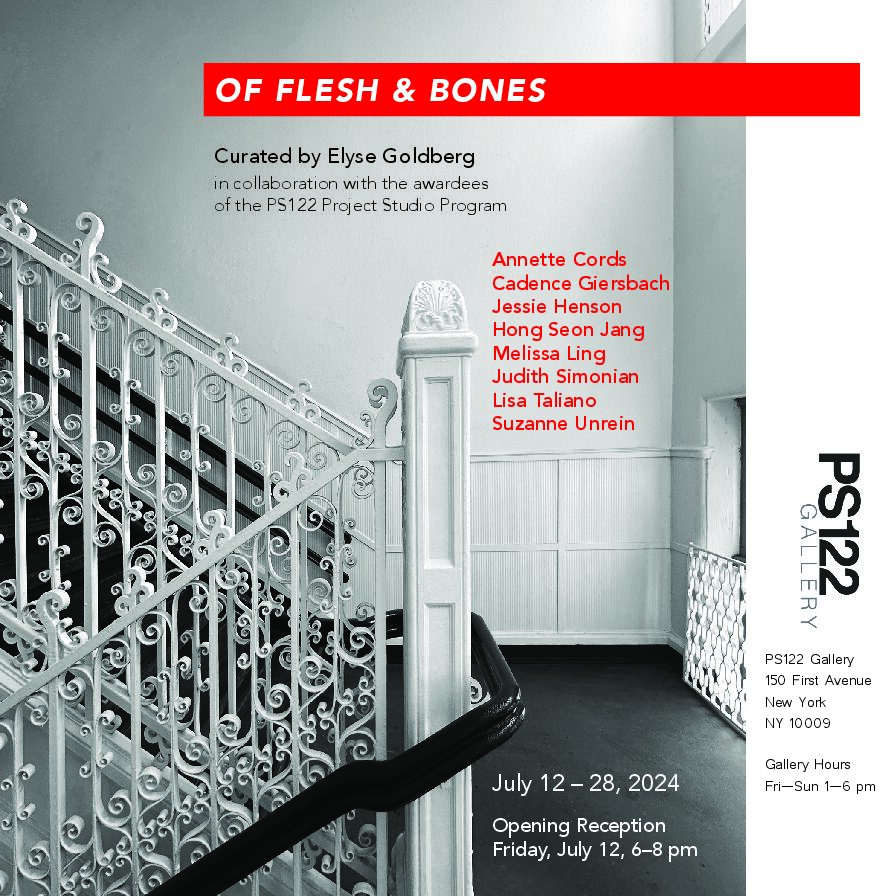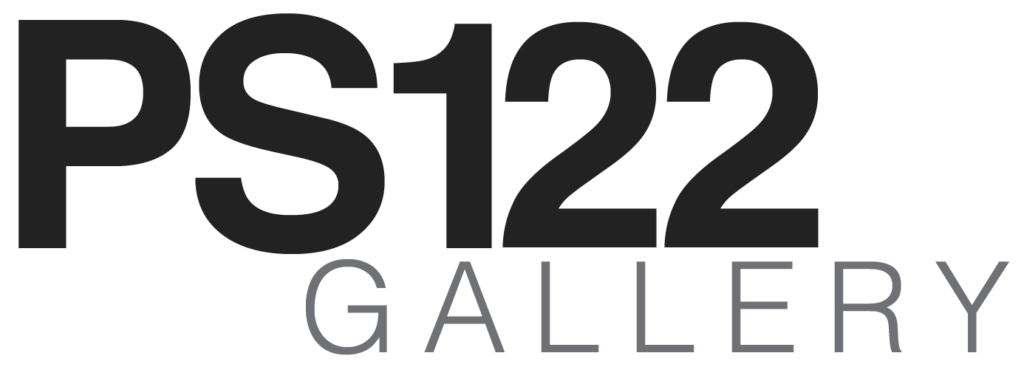
Of Flesh & Bones
Opens on July 12, 2024 at the PS 122 Gallery,
On view through July
28, 2024.
Opening reception: July 12, 6:00-8:00pm
150 1st Avenue, New York, NY,
10009,
PRESS RELEASE
PS122 Gallery is pleased to present Of Flesh & Bones, featuring works by the award recipients of the 2023 -2024
Paintings Space 122 Studio Program: Annette Cords, Cadence Giersbach, Jessie Henson, Hong Seon Jang, Melissa
Ling, Judith Simonian, Lisa Taliano, and Suzanne Unrein in collaboration with curator, Elyse Goldberg.
Of Flesh & Bones initially appeared to be a group show of works by artists whose conceptual modes of work and
aesthetics seemed wildly divergent and thematically unrelated. Soon however, a multi-faceted, synergistic
connective tissue within and between the eight international and inter-generational artists became apparent. And
while disparate themes remained, the essence of strange synchronicity of related interests grew. Long traditions of
art making, conceptual thinking, and subverting materials have given these artists freedom to delve into the means
by which they find the strongest visual forms to speak to our mortality with art at the intersection. They raise
questions, titillate our senses, touch upon the personal and political, create space and vessels for thoughts, all
without claiming truths. The Eurythmics song comes to mind, “Sweet dreams are made of this…”
The works exist in various materials and genres, inclusive of painting, works on paper, fabric constructions,
drawings, conceptual weavings and sculptures. Together, these reveal a central core tendril that explores our
corporeal flesh and bones, literally, figuratively and symbolically.
The show fleshes out our brief, personal moments in time: our musings on love, time, labor, death, autonomy, systems of control, myriad realities. It reminds us that in the process of becoming, we are unbecoming. Our senses are complicated, amused, teased, or awakened to the political arm. What happens when the clapping stops, sound disappears, flesh sensualizes us, fails us, creates boundaries, protects, falls into entropic states and bones crumble? What we leave behind, to time, is our imprint, the memory of us. We must consider how we live in this world as a body, taking up space within the limits of flesh and language.
In Suzanne Unrein’s major painting “What Lies Ahead” (2021), we see ecstatic ruminations on life and mortality,
desire and temptation. This is evident in the elevated, expressionistic meanderings of fusing bodies that appear
and disappear, with flesh unrecognizable as gender specific. Various passages in the muscular imagery merge the
cacophony of multi realities, existing simultaneously within her overall fields of exquisitely fluid use of color and
line. Utilizing figurative abstraction, her figures guilelessly and chaotically merge into humanoids/animals. Devoid
of boundaries, chaos abounds. There is not order in the sensual images, polymorphous, enticing, loaded with vivid
color – blues, reds, purples – against a bright white canvas sea. They ooze with a fury and life – tricksters, denying
the eventual ramifications of decay.
Lisa Taliano’s large scale abstract painting, and this iteration titled “Worlding” (2023), is subtle in its display of body
chimeras, references hidden in architectonic abstraction and semi geometric forms. These form an overall gestalt if
a unified yet dismantled aura. Abstracted body forms sink, dissociate, become disembodied, looking for a restingplace – “worlding” – connected by hinges. The sense of fluid movement fills each canvas. Its parts find each other
in corners on various parts of the canvas. Translucent veils of transparent color quiet the eye and mind. Yet, a sense
of unease remains, with containment marking off from external life outside of the frame. The clever tease of
flattened muted colors in a timeless moment builds a human matrix to be discovered.
Judith Simonian’s large scale landscape painting, “Enter The Mountain, Yellow” (2023), confounds any notion of a
flat canvas surface. Its wry portals, popping up in unexpected areas in the canvas, cracked and fractured, evince
worlds within worlds, creating a space for timelessness which portrays a multitude of parallel universes. Her
investment in the physical behavior of paint closes a gap between illusory references and back to the immediacy
of materials. A tension arises, forging her use of color blocking with collage references. Many physical and
metaphorical layers reside as vibrant and sometimes unintended clashes of color, and the varying types of
brushwork further add a lushness into her landscapes. Mortality is evaded when walking through Simonian’s
nuanced, odd, and unsettling time zones that break any notion of linear time.
Melissa Ling offers cool yet passionate and deeply intense hyper realistic acrylic works on polyester film. Said works
are painted blood-red and dripping, portraying nests that reside within what appear to be tangled tree limbs, blood
vessels, veins and vines. One titled “Bureau” (2024), is a secret nest, alienated from the safety of a forest glen,
alone, centered in the vellum field, removed completely from the larger landscape. It sits, resolutely, in the center
of the translucent field, as if under a microscope and yet, impenetrable. Ling’s organic potentially resilient shelters
will succumb to the passage of time. The nest abode seems a fragment of a dream, a place of safety or danger, a
reminder of Cocteau’s mirrored portal in “Orpheus,” a network or a hidden desire, small deaths in waiting,
mortality lingering.
Cadence Giersbach’s multidisciplinary forms engage a variety of materials, each of which creates its own specific
world, contained, yet Zen-like in quiet restraint. “Red Veil” (2022) is three pieces of fabric sewn together, the outer
edges representing a theatrical-like stage curtain, veil or skirt, with a slit at dead center. Beyond the slit is a red
interior cloth that represents the life force of blood, vitality, and sexuality, against the external image of wavy lines,
representative of the female body, painted onto the outer fabric. “Trail Markers” (2022) is a large work, painted
with black wavy lines on sewn muslin, with simple ribbons – one red, one blue – affixed to its surface, rendering the
work into three dimensions. The work is moved slightly by the air, reminding the viewer that this exists in real
time. “Trail Markers” is reminiscent of topography, aerial views, or the meanderings of human souls whose trails
leave imprints in isolated geographies where one might fall into the abyss.
Annette Cords mysterious and sublime large scale work uses her skills as a weaver in wholly unusual visuals in “Test2 (If/Then, One Game, Many Futures)” (2024). The complex, singular and sublime painterly, large scale, non-
traditional tapestry, “Test 2,” is a version of “If/Then (One Game, Many Futures)” that fully engages language,writing systems and geometries, filtered through a shimmering Jacquard Tapestry (cotton, wool, and acrylic). The
artist utilizes a wide range of techniques, drawings morphed as glyphs, along with photo processes. The
mysterious power of the tapestry is its confounding of layered images, within a black, gray and silvery field of
seemingly broken arcs and lines. There are distilled shapes, a slippage woven together, incomplete, a mind game: a
city yet to be discovered. It simultaneously portends both a dark and utopian reality. Cords’s world – that of
shadowy architecture, utter silence, ancient ruins, hieroglyphics, and broken words that seem to cohere and
dissipate – reflects a potential geographic destination, in and out of focus. “Test 2” reminds us of Pieter Bruegel the
Elder’s “Tower of Babel,” with its largely undecipherable language and worlds, where flesh is abandoned and cities
lie in wait. Might people be living gracefully, within and beyond the weave?
“Free Fall” (2023-2024), Jessie Henson’s impactful work in a medium scale, belies simplicity through its mode of
production. Henson uses an industrial sewing machine, with simple thread, sewn and layered into amulet-like
shields, on heavy paper. Rather than using paint, she complicates the idea of what makes a painting. Her impulse
derives from questioning, how does one find meaning in life’s daily labors? Do they accumulate value, a price to
pay for living? Visually enticing, Henson’s works are slippery. Non-functional, these paintings cannot be worn, do
not protect the flesh. The image cannot be defined, as it is abstract. Henson has elevated the act of sewing to
reflections of labor, inspired by the interpersonal relationship of learning to sew at her mother’s side. “Free Fall”
transforms simple, everyday threads into fragmented fields of sinewy, painterly, abstract objects. Jewel-like, the
image does not fully cover the paper into which it is sewn. The work is as much a painting as a
sculpture. Appearing topographical, her sewn and interlocked threads stretch as if gravity and infinite time are
pulling at their roots. Gold leaf, a desirable precious metal, is also incorporated as a metaphorical protective shield.
Since valuable gold is materially antithetical to the humble thread in value, the issue of labor and class is raised.
The flesh of the paper becomes a second skin that senses an intrusion and reacts by violently recoiling, buckling,
and tensing. Thus it conjures up a corporeal body with the ability to violently torque and twist. The refusal of the
paper to lie flat denotes time, hands that labor, and an unstable body reaching for its place and salvation.
Hong Seon Jang, is an interdisciplinary conceptual artist, born in South Korea, who lives and works in New York.
Jang’s works utilize found objects which he manipulates and decontextualizes, speaking to power dynamics, false
icons, as well as the delusions of authority and its fallout onto citizens. This strategy is found in two exhibited
sculptures: “Mass in B Minor” (2024) and “Pied Piper” (2016) both of which are odes to malevolent human folly
that “delve into the concept of power struggles and challenges.” The former is a monumental hanging sculpture
made from church organ parts to which he affixed a bee hive; the overall effect is a visual reference to a missile.
The latter piece “Pied Piper”, is an intimately powerful work made from a police baton that is ingeniously
transformed into a working flute. Jang is a magician with materials, turning ideas and objects into meditations.
Music and potential violence are married in both works. Jang appropriated the title of “Mass in B Minor” from
J.S.Bach’s master work of the same name in order to explore the universal aspects of religion, ritual, and music’s
qualities of transmutation. Jang has stated “The piece serves as a requiem for the victims of a tragic consequence
of territorial and religious wars throughout human history.” To that end, ongoing religious and/or cultural conflict
which is never-ending also resides in his theme-related piece “Pied Piper,” a metaphor referencing the cautionary
German folktale of a person/leader who makes deceitful promises. Small in scale yet powerful, “Pied Piper” is a chameleon, simultaneously an instrument of subjugation and song. The song leading to death and/or disappearance. Notions of democracy and violence reside like fraternal twins in “Pied Piper.” Its making re- visits Jang’s memories of the 1980’s in South Korea, when mass protests erupted against the military government and dictatorship. During these often violent protests, people were severely beaten as they saw their freedoms
suppressed. To carry out arrests, government forces used instruments that included police batons, water cannons,
and tear gas. “Pied Piper” is a reminder of the tenuous line between what constitutes freedoms, oppression and
hope.
—-Elyse Goldberg
For more information:
PS122 Gallery
150 1st Avenue, Ground floor
New York, NY 10009
[email protected]
(646) 908-7666.
